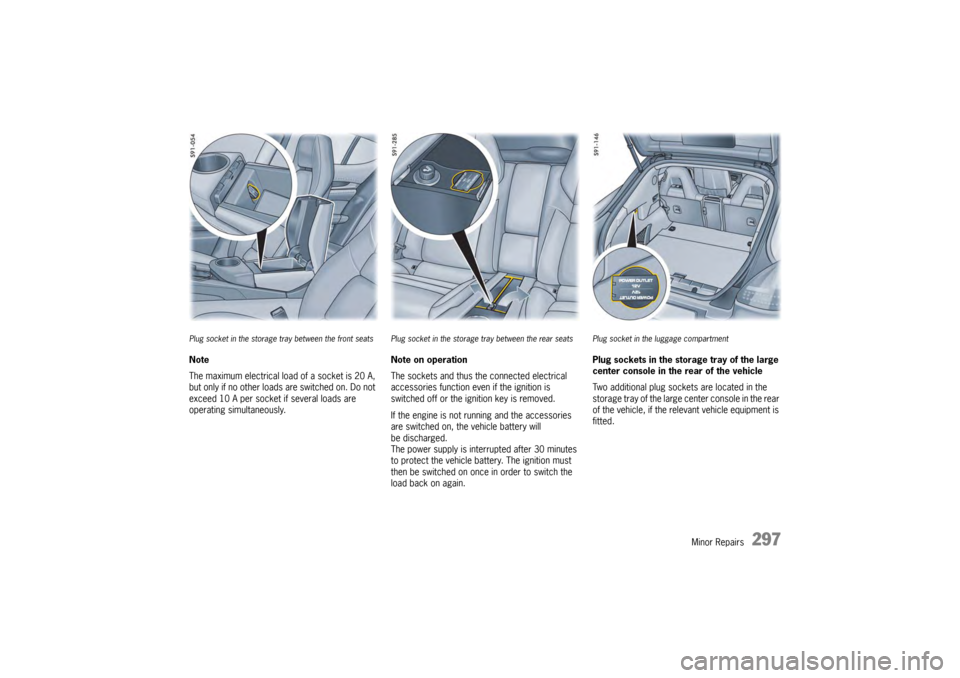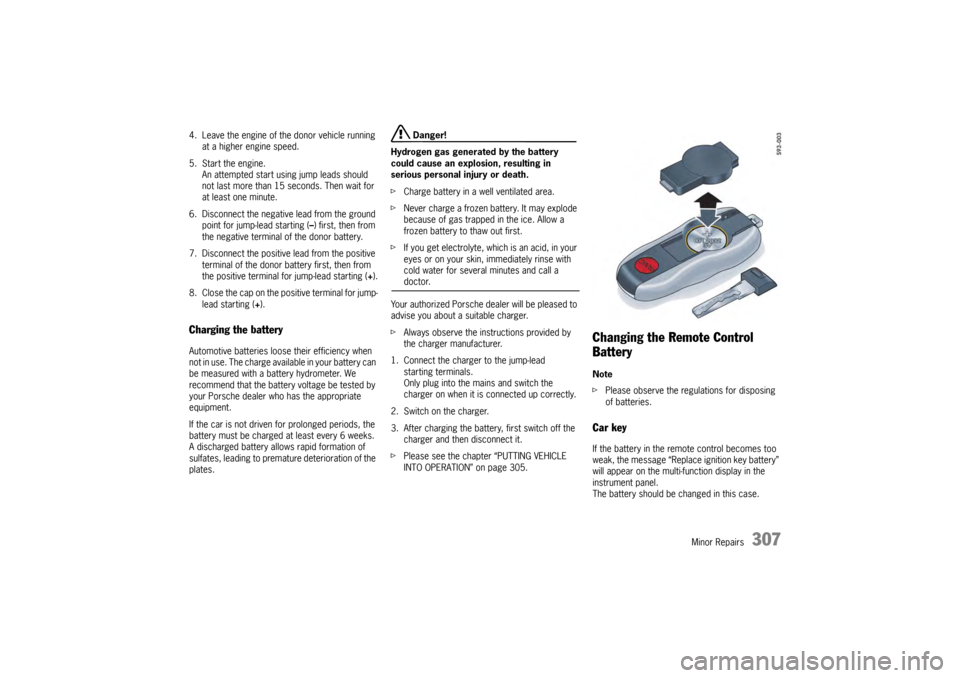2009 PORSCHE PANAMERA key battery
[x] Cancel search: key batteryPage 280 of 343

278
Minor Repairs
Exercise Extreme Caution when
Working on your Vehicle
Danger!
Ignoring the following instructions may
cause serious personal injury or death.
f The engine compartment of any motor vehicle
is a potentially hazardou s area. If you are not
fully familiar with proper repair procedures, do
not attempt the adjustments described on the
following pages.
f O n l y w o r k o n y o u r v e h i c l e o u t d o o r s o r i n a w e l l
ventilated area.
f Ensure that there are no open flames in the
area of your vehicle at any time when fuel
fumes might be present. Be especially
cautious of devices such as hot water heaters
which ignite a flame intermittently.
f Before working on any part in the engine
compartment, turn the engine off and let it cool
down sufficiently. Hot engine compartment
components can burn skin on contact.
f Be alert and cautious around the engine at all
times while it is running. If you have to work on
the engine while it is running, always put the
parking brake on and put the PDK selector
lever in position P or N.
f In particular, be very careful to ensure that
items of clothing (ties, shirt, sleeves etc.),
jewelry, long hair, hand or fingers cannot get caught in the fan, belts or other moving parts.
The radiator and radiator fans are in the front
of the car.
The fans can start or continue running as a
function of temperature,
even with the engine
switched off.
Carry out work in these areas only with the
engine off and exercise extreme caution.
f Your Porsche is equipped with an electronic
ignition system. When the ignition is on, high
voltage is present in all wires connected with
the ignition system; therefore, exercise
extreme caution when working on any part of
the engine while the ignition is on or the engine
is running.
f Always support your car with safety stands if it
is necessary to work under the car. The jack
supplied with the car is not adequate for this
purpose.
Switch off level control of air suspension and
height adjustment.
Please see the chapter “RAISING THE VEHICLE
WITH A LIFTING PLATFORM, TROLLEY JACK
OR STANDARD JACK” on page 290.
f When working under the car without safety
stands but with the wheels on the ground,
make sure the car is on level ground, the
wheels are blocked, and that the engine
cannot be started.
Withdraw ignition keys (switch ignition off in
vehicles that have Porsche Entry & Drive). f
Do not smoke or allow an open flame around
the battery or fuel.
Keep a fire extinguisher close at hand.
f Incomplete or improper servicing may cause
problems in the operation of the car. If in doubt
about any servicing, have it done by your
authorized Porsche dealer.
Improper maintenance during the warranty
period may affect your Porsche warranty
coverage.
f Supplies of fluids, e.g. engine oil, washer fluid,
brake fluid or coolant, are hazardous to your
health.
Keep these fluids out of children's reach and
dispose of them in accordance with the
appropriate regulations.
f Some countries require additional tools and
special spare parts to be carried in your
vehicle. Please make enquiries before driving
abroad.
Note
The tools required for changing a wheel (e.g. jack,
wheel bolt wrench, assembly aids) are not
supplied as standard with the vehicle. Your
authorized Porsche dealer will be pleased to
advise you.
Page 299 of 343

Minor Repairs
297
Plug socket in the storage tray between the front seatsNote
The maximum electrical load of a socket is 20 A,
but only if no other loads are switched on. Do not
exceed 10 A per socket if several loads are
operating simultaneously.
Plug socket in the storage tray between the rear seatsNote on operation
The sockets and thus the connected electrical
accessories function even if the ignition is
switched off or the ignition key is removed.
If the engine is not running and the accessories
are switched on, the vehicle battery will
be discharged.
The power supply is interrupted after 30 minutes
to protect the vehicle battery. The ignition must
then be switched on once in order to switch the
load back on again.
Plug socket in the luggage compartmentPlug sockets in the storage tray of the large
center console in the rear of the vehicle
Two additional plug sockets are located in the
storage tray of the large center console in the rear
of the vehicle, if the re levant vehicle equipment is
fitted.
Page 305 of 343

Minor Repairs
303
Battery
Danger!
Risk of short circuit and fire, resulting in
serious personal injury or death.
f Observe all warning notes on the battery.
f Disconnect the negative terminal on the
battery during all work on the electrical
system.
f Do not lay tools or other metal objects on the
battery as they could cause a short circuit
across the battery terminal.
Hydrogen gas generated by the battery
could cause an explosion, resulting in
serious personal injury or death.
f Charge battery in a well vetilated area.
f Never charge a frozen battery. It may explode
because of gas trapped in the ice. Allow a
frozen battery to thaw out first.
f Do not expose the battery to an open flame,
electrical spark or a lit cigarette.
Risk of explosion as a result of static charge,
resulting in serious personal injury or death.
f Do not wipe the battery with a dry cloth.
f Before touching the battery, discharge any
static electricity by touching the vehicle. Risk of serious personal
injury or death and
damage to the fabric, metal or paint.
f Wear eye protection.
f Do not allow battery acid to come in contact
with your skin, eyes, fabric or painted
surfaces.
f If you get electrolyte, which is an acid, in your
eyes or on your skin, immediately rinse with
cold water for several minutes and call a
doctor.
f Spilled electrolyte must be rinsed off at once
with a solution of baki ng soda and water to
neutralize the acid.
Battery posts, terminals and related
accessories contain lead and lead
compounds, chemicals known to the State of
California to cause cancer and reproductive
harm.
f Always protect your skin by washing
thoroughly with soap and water.
The battery is located in the battery box under the
left front seat.
Charge stateA well charged battery will not only prevent
starting problems but will also last longer.
In order to avoid unintended battery
discharge
f Switch off unnecessary electrical loads in city
traffic, on short trips or in a line of traffic.
f Always remove the ignition key from the
ignition switch when leaving the vehicle or
switch ignition off in vehicles with Porsche
Entry & Drive.
f Avoid using the Porsche Communication
Management system and the audio system
when the engine is not running.
Maintenance note
In the cold season, in part icular, or if you mainly
drive only short distances, it may become
necessary to recharge the battery from time to
time.
Page 306 of 343

304
Minor Repairs
Battery carefEnsure that battery is securely mounted.
f Keep terminals and connections clean and
properly tightened. Corrosion can be
prevented by coating the terminals and
connections with petroleum jelly or silicone
spray.
f Ensure that vent caps ar e securely tightened to
prevent spillage.
Checking the electrolyte fluid level
(only on low-maintenance batteries)
Generally, the electrolyte level must be checked
more often in summer than in the winter, and more
often when driving long distances.
f When adding water, use only clean containers.
In no case may alcohol (e.g. window cleaner
residues) be permitted to enter the battery.
f Unscrew and open the filler vent caps of each
cell.
With the car on a level surface, the fluid level
should meet the indicator mark in each cell.
f If necessary, top up with distilled water. Do not
use acid. Only fill up to the mark, otherwise the
electrolyte will overflow when the battery is
being charged and cause damage.
Winter operationDuring the winter months, battery capacity tends
to decrease as temperatures drop. Additionally,
more power is consumed while starting, and the
headlights, heater, rear window defogger, etc.,
are used more frequently.
f Let your Porsche dealer test the battery's
capacity before winter sets in.Vehicle storageIf the car stands for long periods in the garage or
workshop, the doors and lids should be closed.
f Remove the ignition key and, if necessary,
disconnect the battery.
Notes on operation
f When the battery is disconnected, the alarm
system ceases to function.
If the vehicle was locked before the battery
was disconnected, the alarm will be triggered
when the battery is reconnected.
To deactivate the alarm system:
f Lock the vehicle and unlock it again.
Alarm system, central locking
f The status of the central locking and alarm
system is not changed by disconnecting the
battery. Maintenance notes
Even if you put your vehicle out of operation, the
battery still discharges.
The battery will discharge more quickly if your
vehicle is not driven on a daily basis over a
distance of several miles. The more often you
drive your vehicle, and
the longer the distance
driven on each trip, the more opportunity the
vehicle‘s charging system w ill have to recharge the
batteries.
f To preserve its efficiency, charge the battery
about every 6 weeks.
f Check the battery acid level and top off with
distilled water if necessary.
f Store a battery that has been removed in a
dark, cool place, but not subject to freezing.
Page 307 of 343

Minor Repairs
305
Replacing the batteryThe service life of the battery is subject to normal
wear; it depends greatly on care, climatic
conditions, and driving conditions (distances,
loads).
f Only use an original Porsche battery, with the
correct part number, as a replacement. Only
this battery meets the spec ific requirements of
the vehicle.
f Please observe the disposal instructions for
batteries.
Putting vehicle into operationAfter the battery is connected or after a fully
discharged battery is charged, the PSM warning
light lights up on the instrument panel and
a message appears on the multi-function display
in the instrument panel to indicate a fault.
This fault can be corrected with a few
simple steps:
1. Start the engine. To do this, turn the igni tion key or the control
unit (on vehicles with Porsche Entry & Drive)
to ignition lock position 2, twice .
2. With the vehicle stationary, perform a few steering movements to the left and right and
then drive a short distance in a straight line
until the PSM warning light goes out and the
message is erased from the multi-function
display in the instrument panel.
3. If the warnings do not disappear, then:
Drive carefully to the nearest authorized
Porsche dealer to have the fault corrected.
4. After the warnings go out: Stop the vehicle in a suitable place.
5. Store the end position for the power windows. For information on storin
g the end positions for
the power windows:
f Please see the chapter “STORING END
POSITION OF THE DOOR WINDOWS AFTER
CONNECTING THE VEHICLE BATTERY” on
page 88.
6. Teach tires on vehicles with Tire Pressure Monitoring.
For information on teaching the Tire Pressure
Monitoring system:
f Please see the chapter “TIRE PRESSURE
MONITORING (TPM)” on page 127.
7. Store end position on vehicles with a slide/ tilt roof.
For information on storing the end position for the
slide/tilt roof:
f Please see the chapter “STORING END
POSITION OF THE SLIDE/TILT ROOF” on
page 90.
Page 309 of 343

Minor Repairs
307
4. Leave the engine of the donor vehicle running at a higher engine speed.
5. Start the engine. An attempted start using jump leads should
not last more than 15 seconds. Then wait for
at least one minute.
6. Disconnect the negative lead from the ground
point for jump-lead starting ( –) first, then from
the negative terminal of the donor battery.
7. Disconnect the positive lead from the positive terminal of the donor ba ttery first, then from
the positive terminal for jump-lead starting ( +).
8. Close the cap on the posi tive terminal for jump-
lead starting ( +).Charging the batteryAutomotive batteries loose their efficiency when
not in use. The charge available in your battery can
be measured with a battery hydrometer. We
recommend that the battery voltage be tested by
your Porsche dealer who has the appropriate
equipment.
If the car is not driven for prolonged periods, the
battery must be charged at least every 6 weeks.
A discharged battery allo ws rapid formation of
sulfates, leading to premature deterioration of the
plates.
Danger!
Hydrogen gas genera ted by the battery
could cause an explosion, resulting in
serious personal injury or death.
f Charge battery in a well ventilated area.
f Never charge a frozen battery. It may explode
because of gas trapped in the ice. Allow a
frozen battery to thaw out first.
f If you get electrolyte, which is an acid, in your
eyes or on your skin, immediately rinse with
cold water for several minutes and call a doctor.
Your authorized Porsche dealer will be pleased to
advise you about a suitable charger.
f Always observe the instructions provided by
the charger manufacturer.
1. Connect the charger to the jump-lead starting terminals.
Only plug into the mains and switch the
charger on when it is connected up correctly.
2. Switch on the charger.
3. After charging the battery, first switch off the charger and then disconnect it.
f Please see the chapter “PUTTING VEHICLE
INTO OPERATION” on page 305.
Changing the Remote Control
BatteryNote
f Please observe the regulations for disposing
of batteries.Car keyIf the battery in the remote control becomes too
weak, the message “Replace ignition key battery”
will appear on the multi-function display in the
instrument panel.
The battery should be changed in this case.
Page 310 of 343

308
Minor Repairs
Changing the battery (CR 2032, 3V)
1. Remove the emergency key.
2. Lever off the cover on the back of the key
housing using a small screwdriver.
3. Change the battery (check polarity).
4. Re-fit cover and press together firmly.
5. Insert the emergency key.
Replacing Bulbs
Warning!
Risk of serious personal injury or death. The
headlights are under high voltage when
installed.
f Exercise extreme care when working close to
the headlights.
Risk of short circuit.
f Always switch off the relevant load when
changing bulbs.
Risk of damage. Bulbs of a high wattage can
damage the housing.
f Only use the bulbs specified in the bulb chart.
f Bulbs must be clean and free from grease.
f Never touch bulbs with your bare hands.
Use a cloth or soft paper when
replacing bulbs.
f Always carry spare bulbs with you.
In certain countries, it is mandatory to
carry spare bulbs.
Headlights
Caution!
Risk of damage to headlights due to abrasion
and excessive temperatures.
f Do not affix any coverings (e.g. “stone guards”
or films) on or around the headlights.
f Use soapy water only to clean light lenses and
plastic headlight lenses. In no case may
chemical cleaners or other volatile cleaning
fluids be used.
f To prevent scratches, do not rub with a dry or merely moist cloth, tissue or insect sponges.
Note
The headlights can mist up due to temperature
and humidity.
f To ensure optimum ventilation, do not cover
the gap between headlight and body.
Page 334 of 343

332
Index
Switching on and off .......................................... 170
Automatic (PDK transmission) Rocker switches on the st eering wheel .................. 61
Automatic brake differential (ABD) Functional description . ....................................... 204
Automatic driving light assistant Adaptive light system .. ......................................... 92
Automatic headlight levelling Functional description . ......................................... 94
Automatic speed control (cruise control) Accelerating ........ ...................................... ........ 177
Decelerating........................................... ........... 177
Functional description . ....................................... 176
Interrupting operation.. ....................................... 177
Storing speed.. .................................................. 176
Switching off .................. ................................... 178
Switching on .................. ................................... 176
Automatic transmission...... .......................................... 193
AUX interface, installation position ................................ 192
Auxiliary high-beam headlight Changing bulb ................ ................................... 311
Installing headlights..... ....................................... 309
Removing headlights ....... ................................... 309
BBaby seat
Installing with LATCH sy stem ................................ 56
LATCH restraint system .. ..................................... 56
Prescribed installation direction (depending on
weight of child) ........... ......................................... 53
Battery ........................................ ............................... 191
Care ................... ...................................... ........ 304
Changing in car key .... ....................................... 307
Charge state ... .................................................. 303
Charging ............. ...................................... ........ 307
General information..... ....................................... 303
Jump-lead starting .......... ................................... 306
Location.............. ...................................... ........ 303
Procedure after connectio n ................................ 305
Replacing .................................................. ........ 305
Vehicle electrical system voltage indication .......... 113
Winter driving ..................... ............................... 304
Before driving off .............. .............................................. 4
Belt tensioner Functional description . ......................................... 45 Belts...................
.......................................... ................ 44
Adjusting belt height .......................... ................... 47
Belt tensioner functional description ...................... 45
Care instructions........... ..................................... 276
Fastening ..................... ....................................... 46
Opening ............ ...................................... ............ 46
Warning light on the tach ometer ............................ 45
Bi-Xenon headlight Changing bulb for auxiliary high-beam headlight .... 311
Installing headlights ....... ..................................... 309
Removing headlights ......... ................................. 309
Brake booster ........................ ..................................... 174
Brake fluid Changing .............. ............................................. 259
Warning light on speedometer
............................. 259
Brake pads Breaking in new brake pa ds .................................... 6
Warning message, brakes . ................................. 174
Brake pedal............. .................................................... 173
Brake wear Warning message ............. ................................. 174
Brakes Applying/releasing parkin g brake ........................ 171
Brake pad warning messag e ............................... 174
Brake pedal ...................... ................................. 173
Brake wear warning mess age ............................. 174
Break in new brake pads ........................................ 6
Footbrake.......... ................................................ 172
Test stand ......... ................................................ 253
Break in hints ..................... ............................................. 6
Breaking in Engine ................. ................................................. 6
Engine oil and fuel consumption during break-in
period ...................................... ............................. 6
Hints .................... ................................................. 6
New brake pads and brake discs ............................ 6
New tires .......... .................................................... 6
Brief overview Air conditioning, front co ntrol panel ....................... 68
Air conditioning, rear co ntrol panel ........................ 69
Opening and locking the ve hicle from outside ......... 21
Windshield wipers ............. ................................. 101
Bulbs Changing bulb for auxiliary high-beam headlight .... 311
Changing bulb for licence plate light .................... 313
Changing bulb for side ma rker light ..................... 313 Changing bulb for
side turn signal light................ 312
CCar care
Air bags.............. .............................................. 276
Alcantara ............ .............................................. 276
Alloy wheels .................... .................................. 274
Cleaning the engine comp artment....................... 272
Fabric linings............... ...................................... 276
Headlights, plastic componen ts, adhesive foils .... 274
Laying up your Porsche ..................................... 276
Leather............... .............................................. 275
Paint .................. .............................................. 271
Seals.................. .............................................. 275
Seat belts ....... .................................................. 276
Undercoating ......................................... ........... 273
Use of high-pressure cleaning equipment ............ 270
Washing the vehicle, inst ructions ........................ 270
Wheel bolts ..................... .................................. 293
Windows ............. .............................................. 272
Car key (remote control) Emergency operation of key in ignition lock ......... 166
Locking vehicle door ....... .................................... 24
Unlocking vehicle door . ........................................ 23
Car Telephone ...................... ...................................... 190
Care instructions Air bags.............. .............................................. 276
Alcantara ............ .............................................. 276
Alloy wheels .................... .................................. 274
Car washing .................... .................................. 270
Carpet ................ .............................................. 275
Cleaning the engine comp artment....................... 272
Fabric linings............... ...................................... 276
Headlights, plastic componen ts, adhesive foils .... 274
Laying up your Porsche ..................................... 276
Leather............... .............................................. 275
Mats................... .............................................. 275
Paint .................. .............................................. 271
Radar sensor ......................................... ...........
274
Reversing camera ........... .................................. 274
Seals.................. .............................................. 275
Seat belts ....... .................................................. 276
Ultrasound sensors, Park Assist .......................... 274
Undercoating ......................................... ........... 273
Use of high-pressure cleaning equipment ............ 270